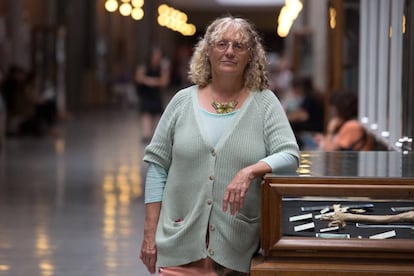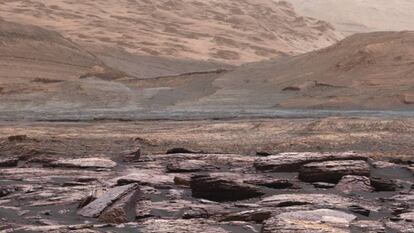Meet the woman looking for aliens under your feet
Penelope Boston has studied some of the most spectacular caves on Earth in her search for microbial life
Penelope Boston has spent the last 25 years visiting some of the most spectacular caves on Earth. Sometimes she needs to wear a special cooling suit and strap on a backpack respirator that produces chilled air. It is the only way to resist, even for just half an hour, the 60ºC inside the Crystal Cave of Naica, in northern Mexico.

To explore these depths “is the closest thing to visiting another planet,” explains Boston, a microbiologist who currently heads the NASA Astrobiology Institute.
Inside the spectacular giant crystals that formed here around 50,000 years ago, there are pockets of fluid. From these, scientists have been able to extract dormant microbes and grow cultures in a lab, thereby bringing them back to life.
I’ve been working on this all my life, I deserve to see it before I die
Penelope Boston
These microorganisms are known as extremophiles because they thrive in some of the most hostile environments on Earth. They can survive without light or water and eat rocks or even toxic compounds, inside abyssal depths where the lack of oxygen and an abundance of gases would kill a person in a matter of minutes.
If there is life on other planets, it is very likely that it is also hiding inside caves and that it looks a lot like the creatures Boston is studying.
Boston is the daughter of an actor and a dancer who emigrated to the United States from Europe following World War II. When she began working in her field in the early 1990s, very few people believed that there could be underground life forms. The first research projects that were financed by US agencies sought to find out whether it would be possible to introduce microbes underground in order to clean up radioactive contamination from nuclear bombs.
“But when they started to study it, they saw that the microbes were already there,” recalls Boston.
This researcher has focused on a few dozen caves that are particularly interesting because of the microbes they contain. One of them is Lechuguilla – one of the longest caves in the world – and another is Snowy River, which contains an 18-kilometer-long stream bed made of petrified white calcite. Both are located in New Mexico.

Boston recalls the time when she and her entire team nearly died from the sulfur emissions inside Villa Luz, a cave in the Mexican state of Tabasco.
“The concentration of oxygen in the air is 21%, and that time the meter went down to 9%. I was screaming but nobody could hear me with my mask on. After that, we started carrying oxygen bottles with us,” she recalls.
“What I’ve discovered throughout my career is how different the various life forms can be from one cave to the next. This diversity is controlled by geochemistry. It’s as though each cave were a completely different planet,” says the researcher, who was in Madrid recently to take part in a symposium on extremophiles organized by the Ramón Areces Foundation.
These microorganisms are known as extremophiles, they thrive in some of the most hostile environments on Earth
Boston studies the mineral formations left by many of these microbes when they feed, and which on other planets could constitute a sign of life.
But reaching the caves and cracks of Mars, Europa or Enceladus – the sixth-largest moon of Saturn – with a rover remains a challenge that is still beyond the technological ability of NASA or any other space agency, she admits.
“My opinion is that the first signs of life beyond Earth will not be found in the Solar System but in the atmosphere of exoplanets. There are thousands of possibilities, and we will soon be launching the James Webb telescope next year, and that will open up a whole new range of sensibility,” she says.
Boston harbors no doubt that Mars will be colonized one day, although not as soon as the visionary entrepreneur Elon Musk says. And caves will play a fundamental role once this happens because they offer a perfect habitat.
Boston has worked on studies for NASA on how to use inflatable materials to line the inside of a cave and make it livable, which is a much cheaper and more efficient option than building a colony in space, she says. The Mars Reconnaissance Orbiter (MRO) probe has revealed that the Red Planet has more than 2,000 cavities that could be used in this way.
The researcher, who was born in the 1950s, trusts that she will live long enough to see humanity reach Mars in the 2030s.
“I’ve been working on this all my life – I deserve to see it before I die,” she jokes.
English version by Susana Urra.
Tu suscripción se está usando en otro dispositivo
¿Quieres añadir otro usuario a tu suscripción?
Si continúas leyendo en este dispositivo, no se podrá leer en el otro.
FlechaTu suscripción se está usando en otro dispositivo y solo puedes acceder a EL PAÍS desde un dispositivo a la vez.
Si quieres compartir tu cuenta, cambia tu suscripción a la modalidad Premium, así podrás añadir otro usuario. Cada uno accederá con su propia cuenta de email, lo que os permitirá personalizar vuestra experiencia en EL PAÍS.
¿Tienes una suscripción de empresa? Accede aquí para contratar más cuentas.
En el caso de no saber quién está usando tu cuenta, te recomendamos cambiar tu contraseña aquí.
Si decides continuar compartiendo tu cuenta, este mensaje se mostrará en tu dispositivo y en el de la otra persona que está usando tu cuenta de forma indefinida, afectando a tu experiencia de lectura. Puedes consultar aquí los términos y condiciones de la suscripción digital.











































